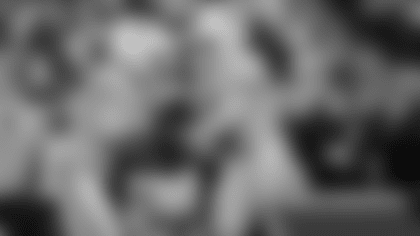RB Cadillac Williams has had some good moments against Carolina, but his last run in Charlotte last September was a tough one
Cadillac Williams had a clue that something was seriously wrong.
There was the pain, of course...no shortage of that. But something else had tipped the Tampa Bay Buccaneers running back off to the severity of the injury he had just suffered at the end of an 18-yard run against the Carolina Panthers last September.
The clue had to do with his right kneecap. Specifically, it wasn't really on top of his knee anymore.
"I knew right out of the jump my kneecap wasn't supposed to be there," says Williams, sending a room of well-wishers looking for news on his recovery into a round of laughter. He doesn't specify exactly where he found his kneecap that Sunday in Charlotte, but it had clearly made an unwelcome little journey. "I can remember it like it was yesterday. I said, 'Yo, it's bad.'"
Williams can smile about his grisly injury now, five and a half months later. In fact, as he sits down at a conference table after another morning rehab session at One Buccaneer Place, he's in a positively good mood, cracking jokes and putting a light spin on what had been some heavy subject matter. He describes the sight of his atrophying right quad muscle, post-surgery, with mock horror, chuckling at the way it jiggled instead of stood firm.
"And, you know, my quads are my best future, as far as going forward," quips Williams. "Besides [my] looks!"
It wasn't always this easy to laugh.
Williams couldn't move his right leg for weeks after the surgery to repair a shocking knee injury suffered on September 30, one that most notably included a torn patellar tendon. He would lie in bed, letting his mom fawn over him, watching his team go on without him, listening to media reports that his entire NFL career might be over.
As the Bucs' successful quest for the NFC South title wound down, Head Coach Jon Gruden was asked about the man who was supposed to be the focal point of his offense. Gruden expressed confidence about Williams' ability to overcome his misfortune, but admitted that the back was in a "dark and lonely place" at the time.
Looking back, Williams doesn't argue.
"Truth be told, it was," he says, after pausing for a moment to recapture the way he was feeling, to try to frame the emotional devastation of the first few months after his injury. "This was Year Three [of his NFL career], coming in. The pieces were in place. I'm feeling good about it, feeling like myself and the Bucs are going to have a good year. Then boom, this happens.
"The severity of it and the way things happened, just being in the bed, having to watch, having to hear the rumors and this and that. It was tough, it really was. It was a tough state. I think maybe the first two months were the toughest. I think for close to five, maybe six weeks, it was a stage there where I basically couldn't move my leg. I couldn't walk, couldn't do anything."
Williams got hurt on the last day of September and went under the knife the next week. He was told that his particular injury and corrective procedure was usually followed by a recovery period of nine to 12 months. He was told of several other NFL players who had returned to the field after the same injury, including Philadelphia running back Correll Buckhalter and former Buccaneers linebacker Nate Webster.
Williams said he was "wound up" as soon as he came out of surgery, looking for specifics from his surgeon, the well-known James Andrews, as to how long he would be out of the game. Later, he calmed down and, after those "dark days" in the first few months, simply chose to narrow his focus and attack the day at hand.
"Everybody's different, everybody's body responds differently. It's been an uphill battle. I know what I have to do and I'm just taking it one day at a time.
"Dr. Andrews let me know that it was going to be a lengthy process. He said the main thing I need to do is stay patient, let my body heal and continue to work. Basically, that's the approaching I'm taking. I guess after that three-and-a-half, four months I started turning that corner. I started seeing that light. 'Okay, I'm getting active on it. It's feeling better. I can do some things on it.'"
A typical day of rehab for Williams might involve one-legged squats, full-speed running in the submerged treadmill in the One Buc Place hydrotherapy room or even running the stairs at Raymond James Stadium. Last week he started making quick cuts and pushing a blocking sled. He is encouraged by how the knee has held up to the added pressure.
Each step gets him closer to putting the pads back on and resuming his very promising career. But Williams is making a point of not looking too far down the road just yet.
"Me personally, I would love to be ready for training camp, ready for opening day," he said. "That's my goal, but at the same time, we've got to be smart with it. I'm just continuing to work, and come training camp and come the season we'll see how things are going with it and take it from there."
The next day of rehab might bring even more encouragement, or it might not. There's no guarantee his recovery will be a smooth process; instead, it may include big leaps forward or occasional setbacks. But Williams has already taken the biggest step, casting off the weight that fell over him in the weeks following his injury and getting his drive back.
And his smile.
"I know I'm doing a lot better the past couple of months," said Williams. "I got off to a slow start but I'm starting to see the light at the end of the tunnel. I'm just making progress."
























